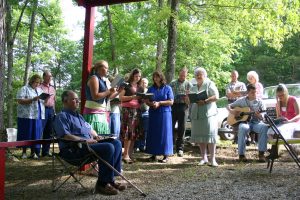
Decoration Days are an important part of Appalachian ritual life. Usually held in the summer, these days are set aside by families and church congregations to clean and decorate their cemeteries. These annual homecomings, often on a Sunday in June, reunite those who have moved away. Preaching, singing (often shape note singing), and a communal dinner on the grounds all contribute to the day’s celebration. But the main purpose is to honor the dead and reaffirm the ties of the living to them. Grave sites are cleared of debris, weeds, and overgrowth. They are carefully raked and then beautified with flowers, banners, flags, and other memorials. In this way, family and community ties continue to be nourished despite separations caused by time and space.
Decoration Day reconnects mountain residents with lost loved ones. Every spring, thousands of mountain people gather in cemeteries to remember and respect the deceased by cleaning and decorating their graves with flowers. It is both a religious event and a celebration of life where people pray, sing, share a meal commonly called Dinner on the Ground, tell stories, and reconnect as a community. In the mountains, Decoration Day events, often called “decorations,” occur anytime from April to October, with most held in May and June.
 Cleaning is an integral part of Decoration Day, occurring as early as a week before to the morning of, depending on the region. In western North Carolina, Decoration Day usually occurs on Sunday, with cleaning within the preceding week. Cleaning involves removing grass and weeds from around the graves, along with leftover flowers or old decorations. Occasionally, it even involves mounding dirt over the graves to create a raised bed for the flower decorations.
Cleaning is an integral part of Decoration Day, occurring as early as a week before to the morning of, depending on the region. In western North Carolina, Decoration Day usually occurs on Sunday, with cleaning within the preceding week. Cleaning involves removing grass and weeds from around the graves, along with leftover flowers or old decorations. Occasionally, it even involves mounding dirt over the graves to create a raised bed for the flower decorations.
Flowers are an essential part of Decoration Day. Each grave must be decorated and many families bring hundreds of flowers to a decoration. Fresh flowers are considered the best, but artificial flowers of many types have been used for generations, including homemade crepe paper flowers. These flowers can be placed on graves in any number of ways, but creating a pleasing pattern is important. Most commonly, a row of individual flowers is placed running the length of the grave. Alternatively, flowers may be gathered into large bouquets and placed in a row. Creating a blanket of flowers covering an entire grave is especially common for new burials. Other flower decorations include single stems, posies, saddle decorations on headstones, flowers in urns, and wreaths.
 Flowers are not the only things left at graves. Leaving items that a person enjoyed in life is a common way to connect with the dead. Angel figurines, inspirational sayings, and everything from fishing lures to work boots are also displayed. Shepherd’s crooks with hanging ornaments are now common, allowing people to leave more items without getting in the way of lawn mowers. Additionally, it is a common belief that every grave should be decorated – even those of total strangers. Decoration Day participants feel responsible for all the graves in a cemetery. This consciousness helps transform Decoration Day from a personal act of remembrance to a community event.
Flowers are not the only things left at graves. Leaving items that a person enjoyed in life is a common way to connect with the dead. Angel figurines, inspirational sayings, and everything from fishing lures to work boots are also displayed. Shepherd’s crooks with hanging ornaments are now common, allowing people to leave more items without getting in the way of lawn mowers. Additionally, it is a common belief that every grave should be decorated – even those of total strangers. Decoration Day participants feel responsible for all the graves in a cemetery. This consciousness helps transform Decoration Day from a personal act of remembrance to a community event.
 Decoration Days are religious events, although most decorations are not sponsored by a church. Many family and community cemeteries exist without a church nearby, and people from several churches may attend a decoration. Decoration Day services almost always take place on Sundays. They are usually held outdoors and are informal, though they include both preaching and hymn singing. Singing is always important, featuring gospel hymns often with guitar and fiddle accompaniment.
Decoration Days are religious events, although most decorations are not sponsored by a church. Many family and community cemeteries exist without a church nearby, and people from several churches may attend a decoration. Decoration Day services almost always take place on Sundays. They are usually held outdoors and are informal, though they include both preaching and hymn singing. Singing is always important, featuring gospel hymns often with guitar and fiddle accompaniment.
Decoration Day has serious elements, but it is also a celebration. Families and communities come together to tell stories and reconnect with friends they might see only once a year. For young adults, Decoration Day has always been a time to socialize and hang out while younger children play throughout the cemetery.
Decoration Day is practiced throughout the South from Virginia to Texas. A similar custom in the North, Memorial Day, was once also called Decoration Day. It was established after the Civil War to honor military dead. Soon after the Civil War, Mary Cunningham Logan was in Petersburg, Virginia and observed the decorations left in the church graveyard there. She suggested the idea of decorating the graves of fallen soldiers to her husband U.S. General John Alexander Logan. Logan then created Memorial Day to honor American war dead. It seems likely that the Southern tradition helped create the national holiday. Similarly, many Northerners used Memorial Day to decorate their own family graves.
Decoration Days are informal affairs. Individuals decide how graves are decorated, and communities determine how and when events will be held. Decorations bring together communities of the living and connect them with communities of the dead, which is represented through flowers, a symbol of life, left on the graves.

This essay is based on the work of Alan Jabbour and Karen Singer Jabbour, together with an exhibit created by the Mountain Heritage Center. Much of the material is taken from their book Decoration Day in the Mountains: The Tradition of Cemetery Decoration in Western North Carolina and the Upland South, published in 2010 by the University of North Carolina Press. All photographs are by Karen Singer Jabbour.
Multimedia:
Below is the Digital Heritage Moment as broadcast on the radio:
[audio:http://dh.wcu.edu/wp-content/uploads/2010/08/Decoration-Day60Mx.mp3|titles=Decoration Day60Mx]

